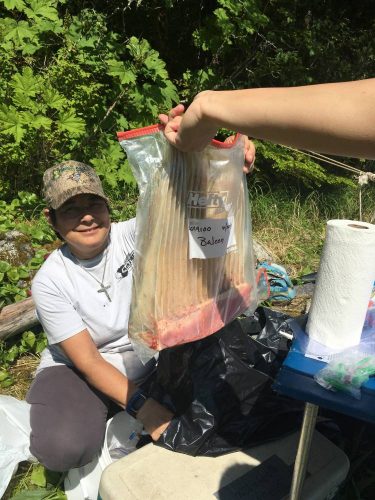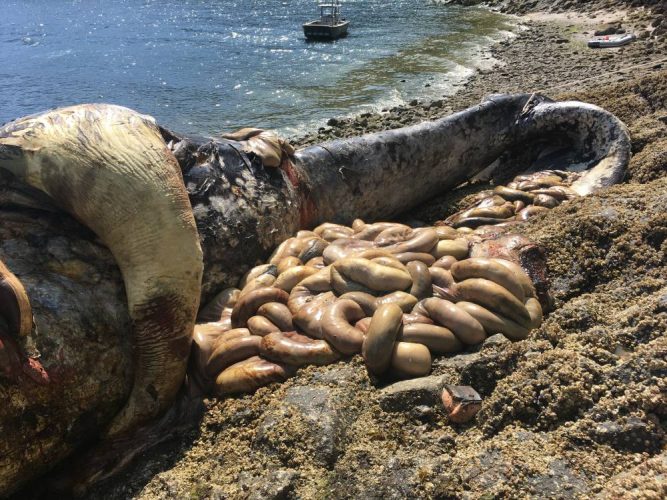
Biologists in Southeast Alaska are racing to examine a wave of whale carcasses to try and find what’s killing gray whales up and down the Pacific Coast. Nearly 170 have been reported triggering NOAA Fisheries to launch an investigation.
When a dead whale was reported floating near Wrangell, the troops had to rally. U.S. Forest Service workers found the carcass on this remote beach and tied it to trees so it wouldn’t float away.
The site is on Wrangell’s Eastern Passage. You have to travel by boat to the site, about 10 miles southeast of town.
Translucent Tyvek poly-suits are the fashion among the dozen wildlife workers and volunteers gathered around the 35-foot-long carcass of the male juvenile.

This isn’t a pleasure beach. You have to tiptoe across nearly impossible rocky incline to get to the specimen.
NOAA Fisheries veterinarian Kate Savage got the call in Juneau.
At least a dozen gray whales have been reported in Alaska. Savage has performed over 20 whale necropsies. By now she knows what she’s looking for as her crew strips the layers of tissue off the carcass.
Savage assembled a team of local, citizen scientists. Anna Allen is a Wrangell-based technician who works for the Alaska Department of Fish and Game.
“It is sad to see, but it is also an amazing opportunity to be part of this team and be part of this phenomenon,” she said.
An amazing opportunity and a gross one. The carcass is baking in the mid-70s-degree heat. Allen says the smell is the worst she’s ever encountered.
“It’s like a mixture of barf and poop,” she said. “I don’t think I’ll find anything remotely close. I’ll never complain about things that smell bad ever again.”
The team spends the afternoon cutting through blubber and tissue to get to the stomach and intestines. Allen is already looking forward to showering.
“We were trying to get fecal matter out of the intestines, and there was just a buildup of gas, and we cut into it and it kind of just exploded,” she said. “Somehow it only got on me.”

These teams rush to carcasses that are relatively fresh and accessible in the hopes of solving the mystery: why are gray whales dying?
Deaths along Mexico to Alaska total nearly 170 now. Five whales were reported in Alaska in just over a week, with three in Southeast, one in Bristol bay, and one near Kodiak.
That brings the tally to at least a dozen this year in Alaska alone.
NOAA is in its first month of an investigation into why. Declaring this mortality event brings in more funding, experts and a push for public reporting to solve the mystery. The necropsy today is a fact-finding mission to add to the national effort.
NOAA Fisheries spokeswoman Julie Speegle in Juneau says public reports are important because it allows biologists to respond quicker.
“The amount of information we can get on a fresh carcass is so much better because the samples are in much better shape,” she said.
Of the dozen dead gray whales confirmed so far NOAA has been able to collect baleen, tissue, and feces from four. Authorities are certain there are many more that remain uncounted. That’s because, Speegle says, only about a tenth of dead whales are recovered.
“So the animals we do reach to conduct a necropsy are representative of the many more we don’t see that fall to the ocean bottom,” she said.
The investigation could take months or years. And the mystery might never be solved.
In 1999, NOAA declared an “unusual mortality event” after about 650 dead grey whales were reported up and down the West Coast over two years. But by 2001, the numbers dropped. No definitive cause was found but the high death rate subsided — until now.
Back on Wrangell’s rocky beach, the site of the dead whale, Savage says the theories posited 20 years ago are the working hypothesis used today: Malnutrition, bio toxins.
Then there are the knock-on effects of climate change and with it, vanishing sea ice.
“That impacts just a slew of different species on every level, and I personally think gray whales are just one of the victims,” Savage said. “But that’s just one of my theories and I’d be open to changing that if we had evidence of something different.”
After packing up their samples, the team doesn’t plan to come back. The carcass will remain tied to the beach where it will take months to decompose. As the tides change, land and sea animals can feed off of it. Even though the deaths are unusual, and the causes unknown, nature continues.











